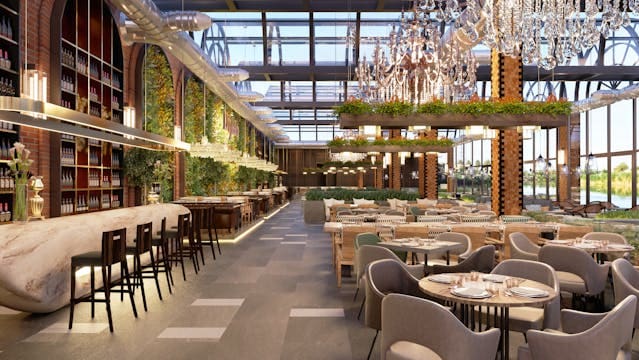Walk into any well-run café, hotel, or restaurant, and you’ll notice something you can’t quite put your finger on. The space feels alive, with the rhythm of conversation, the hum of activity, and somewhere beneath it all, music that just fits.
Whether it’s soft jazz over breakfast or an upbeat mix during evening service, these background choices aren’t random. They’re part of a carefully crafted ambiance that shapes how customers feel, stay, and remember the experience.
In hospitality, music is more than decoration. It’s an emotional connector that subtly influences behavior, mood, and perception. That’s why so many venues now treat sound with the same care as lighting or interior design, often turning to background music for restaurants to ensure their sound fits their brand and stays legally compliant.
Music as a Mood Designer
Different genres create different atmospheres. A café might start the morning with acoustic or lo-fi tracks that match the calm ritual of coffee and conversation. By lunch, a brighter tempo lifts the room’s energy without overwhelming it. Come evening, slower or more ambient selections invite guests to unwind.
Hotels use similar thinking but across multiple spaces, with upbeat playlists in the lobby to convey warmth and welcome, instrumental music in spas to encourage calm, and refined jazz or soul in restaurants for sophistication. The result is a consistent yet adaptive sound identity that complements each part of the guest journey.
This approach extends beyond preference. Studies in environmental psychology show that tempo, rhythm, and genre can directly affect how long people linger and how much they spend. Slow music can increase dwell time, while faster beats can turn tables efficiently in high-demand settings. It’s not manipulation; it’s mindful design.
Aligning Music with Brand Identity
Just as décor and menu reflect a brand’s story, so does its sound. A boutique hotel in the city might curate indie playlists to feel creative and modern, while a coastal resort could favor acoustic or tropical tones that blend with natural surroundings. A restaurant serving traditional cuisine might weave in regional influences, reinforcing cultural authenticity.
When the sound aligns with the space’s visual and service identity, the brand becomes immersive. Customers don’t just eat or stay, they feel the brand’s character. And that’s what turns a one-time visit into a lasting impression.
Adapting to Time and Audience
The best hospitality venues know that one playlist doesn’t fit every hour. Music should shift with the rhythm of the day and the type of crowd. Morning guests tend to favor softer, calmer soundscapes. Afternoon brings a more casual energy, ideal for mid-tempo tracks that keep the pace steady. Evenings invite depth, with richer tones, fuller instrumentation, and slower tempos that encourage relaxation.
Technology now makes this easy. Many background music platforms allow automatic scheduling, so playlists evolve seamlessly throughout the day. Staff don’t need to manage it because the system knows when to transition from brunch to dinner or from lobby buzz to nighttime calm.
Staying Compliant with Licensed Music
One area that’s often overlooked is music licensing. Playing music publicly, whether from Spotify, Apple Music, or personal libraries, requires proper commercial licensing. Without it, venues risk fines and legal issues from performance rights organizations.
Licensed music services simplify this process by providing pre-cleared, high-quality tracks designed specifically for business use. They manage all the legal requirements while giving users creative control to choose playlists that suit their venue. That means owners can focus on ambiance and consistency, knowing the sound is both stylish and compliant.
Data-Driven Sound Choices
Modern hospitality businesses are also learning from data. Music analytics tools can show how certain playlists influence sales, table turnover, or customer satisfaction. For example, a wine bar might discover that acoustic soul increases average spend during happy hour, while a hotel might find that calmer lobby music improves guest ratings for comfort.
This feedback loop helps fine-tune playlists not just for style but for measurable impact. It turns sound from a background element into a strategic asset that contributes to revenue and reputation.
The Invisible Thread of Experience
When guests recall a great stay or meal, they might mention the food, the service, or the décor. Rarely do they mention the music, yet it plays a silent role in tying all those details together. It’s what makes a room feel inviting, a dinner feel intimate, or a morning coffee feel like a ritual.
Hospitality thrives on atmosphere, and music is one of its most powerful yet underappreciated tools. The right playlist doesn’t just fill silence; it fills space with feeling.
By choosing thoughtful, licensed music programs, cafés, hotels, and restaurants can create experiences that resonate beyond sound; experiences that keep customers coming back, often without even knowing why.
The New Jersey Digest is a new jersey magazine that has chronicled daily life in the Garden State for over 10 years.
- Staffhttps://thedigestonline.com/author/thedigeststaff/
- Staffhttps://thedigestonline.com/author/thedigeststaff/
- Staffhttps://thedigestonline.com/author/thedigeststaff/
- Staffhttps://thedigestonline.com/author/thedigeststaff/


